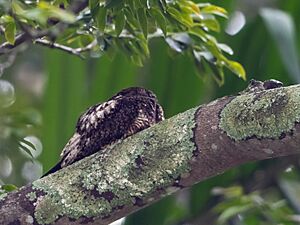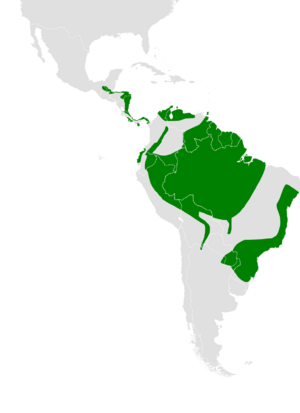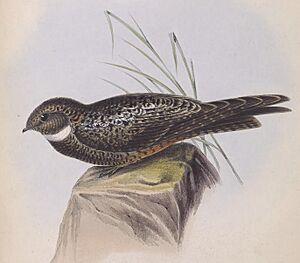Short-tailed nighthawk facts for kids
Quick facts for kids Short-tailed nighthawk |
|
|---|---|
 |
|
| Conservation status | |
| Scientific classification | |
| Genus: |
Lurocalis
|
| Species: |
semitorquatus
|
 |
|
|
Approximate range map
of short-tailed nighthawk |
|
The short-tailed nighthawk (Lurocalis semitorquatus) is a type of bird known as a nightjar. It belongs to the Caprimulgidae family. You can find this bird in Mexico, most countries in Central America (except El Salvador), Trinidad and Tobago, and many parts of South America. It lives in every mainland South American country except Chile and Uruguay.
Contents
About the Short-tailed Nighthawk
What's in a Name?
The short-tailed nighthawk got its official name in 1789 from a German scientist named Johann Friedrich Gmelin. He first put it in the Caprimulgus group, which includes all nightjars.
Later, in 1851, an American bird expert named John Cassin created a new group, or genus, called Lurocalis just for this bird and one other. The name Lurocalis comes from ancient Greek words meaning "tail" and "stunted," which describes its short tail. The second part of its name, semitorquatus, is Latin for "half-collared" or "small-collared," referring to a mark on its throat.
Different Types of Short-tailed Nighthawks
There are four main types, or subspecies, of the short-tailed nighthawk:
- L. s. stonei – Found from southeast Mexico to northwest Ecuador.
- L. s. semitorquatus – Lives in northern Colombia, the Guianas, northern Brazil, and Trinidad and Tobago.
- L. s. schaeferi – Found in a specific area of northern Venezuela called Aragua.
- L. s. nattererii – Lives in the Amazon region, south of the Amazon River, and down to northern Argentina.
What Does the Short-tailed Nighthawk Look Like?
This bird is about 19 to 21 cm (7.5 to 8.3 in) long. It's a fairly large nightjar, but it has a very short tail, which is unusual for its family.
Its feathers are mostly dark brown to blackish on top, with some reddish-brown and light brown spots. Its wings are also dark brown with faint spots. Unlike many other nighthawks, it doesn't have bright white marks on its wings. The tail is brown with light brown or grayish stripes and a thin, light band at the very end.
The short-tailed nighthawk has a dark brown chin and a white throat. Its upper chest is dark brown with lighter speckles, while its lower chest is light brown with brown stripes. Its belly and sides are a reddish-brown color with brown stripes. The different subspecies can vary a bit in size and how many spots or stripes they have.
What Does It Sound Like?
The sound of the short-tailed nighthawk changes slightly depending on the subspecies. Some describe its call as a repeated "ewIT ... ewIT ... ewIT ..." sound. Others say it sounds like a sharp, slightly wet "g'wik" or "gweek." It makes these sounds both when it's sitting still and when it's flying.
Where Do Short-tailed Nighthawks Live?
This bird lives across a wide area, including Central America and the northern parts of South America. It mostly prefers evergreen forests in low-lying areas. However, you can also find it in more open places like clearings, along river edges, in old cacao farms, and in forests that are growing back after being cut down.
Birds in the northern parts of their range usually stay in the same place all year. But the ones further south sometimes travel north to places like Venezuela during the southern winter.
How Do Short-tailed Nighthawks Behave?
Feeding Habits
The short-tailed nighthawk is an aerial insectivore, meaning it catches insects while flying. It mostly hunts at dusk, which is when the sun is setting. While we don't know every detail of its diet, we know it eats things like beetles and true bugs.
You usually see these birds alone or in pairs, but sometimes they hunt in small groups. Their flight is very fast and unpredictable, often compared to how a bat flies. When they rest, they perch lengthwise on a thick tree branch.
Reproduction and Nesting
The short-tailed nighthawk is special because it's one of the only birds in its family known to nest in trees. It lays just one egg directly on a large, flat tree branch, without building any kind of nest material around it.
Conservation Status
The IUCN (International Union for Conservation of Nature) has listed the short-tailed nighthawk as a species of "Least Concern." This means it's not currently in danger of disappearing. It lives across a very large area and has a big population. However, the number of these birds is thought to be slowly going down. The main threat identified is local deforestation, which means trees being cut down in certain areas.



